Took off in Spitfire Mark IX .
Fleming, John Wallace (Flying Officer)
Prisoner of War 1944-June-30


Birth Date: unkown date
Born:
Parents:
Spouse:
Home: Markham, Ontario
Enlistment:
Enlistment Date: unkown date
Service
RCAF
Unit
441 Sqn- Squadron
Stalk and Kill
Base
Rank
Flying Officer
Position
Pilot
Service Numbers
J/25138
PoW: 4703
Crew or Other Personnel
Spitfire MK737
Spitfire serial: MK737
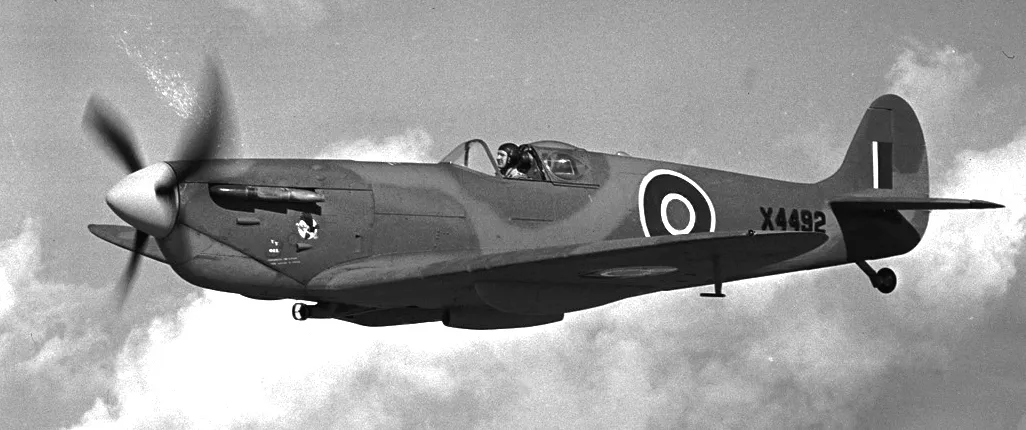
Supermarine Spitfire Mk. VI, RCAF (Serial No. X4492), in flight, 26 Feb 1944.
The Supermarine Spitfire is a British single-seat fighter aircraft that was used by the Royal Air Force and other Allied countries before, during, and after World War II. Many variants of the Spitfire were built, using several wing configurations, and it was produced in greater numbers than any other British aircraft. It was also the only British fighter produced continuously throughout the war. The Spitfire continues to be popular among enthusiasts; around 70 remain airworthy, and many more are static exhibits in aviation museums throughout the world.
The Spitfire was designed as a short-range, high-performance interceptor aircraft by R. J. Mitchell, chief designer at Supermarine Aviation Works, which operated as a subsidiary of Vickers-Armstrong from 1928. Mitchell pushed the Spitfire's distinctive elliptical wing with cutting-edge sunken rivets (designed by Beverley Shenstone) to have the thinnest possible cross-section, helping give the aircraft a higher top speed than several contemporary fighters, including the Hawker Hurricane.
The Spitfire had detachable wing tips which were secured by two mounting points at the end of each main wing assembly. When the Spitfire took on a role as a high-altitude fighter (Marks VI and VII and some early Mk VIIIs), the standard wing tips were replaced by extended, "pointed" tips which increased the wingspan from 36 ft 10 in (11.23 m) to 40 ft 2 in (12.24 m). The other wing-tip variation, used by several Spitfire variants, was the "clipped" wing; the standard wing tips were replaced by wooden fairings which reduced the span by 3 ft 6 in (1.07 m). The wing tips used spruce formers for most of the internal structure with a light alloy skin attached using brass screws.
Due to a shortage of Brownings, which had been selected as the new standard rifle calibre machine gun for the RAF in 1934, early Spitfires were fitted with only four guns, with the other four fitted later. Early tests showed that, while the guns worked perfectly on the ground and at low altitudes, they tended to freeze at high altitude, especially the outer wing guns, because the RAF's Brownings had been modified to fire from an open bolt. While this prevented overheating of the cordite used in British ammunition, it allowed cold air to flow through the barrel unhindered. Supermarine did not fix the problem until October 1938, when they added hot air ducts from the rear of the wing-mounted radiators to the guns, and bulkheads around the gunbays to trap the hot air in the wing. Red fabric patches were doped over the gun ports to protect the guns from cold, dirt, and moisture until they were fired.
The first Rolls-Royce Griffon-engined Mk XII flew in August 1942, and first flew operationally with 41 Squadron in April 1943. This mark could nudge 400 mph (640 km/h) in level flight and climb to an altitude of 33,000 ft (10,000 m) in under nine minutes. As American fighters took over the long-range escorting of USAAF daylight bombing raids, the Griffon-engined Spitfires progressively took up the tactical air superiority role, and played a major role in intercepting V-1 flying bombs, while the Merlin-engined variants (mainly the Mk IX and the Packard-engined Mk XVI) were adapted to the fighter-bomber role. Although the later Griffon-engined marks lost some of the favourable handling characteristics of their Merlin-powered predecessors, they could still outmanoeuvre their main German foes and other, later American and British-designed fighters.Wikipedia
 Wikipedia Supermarine Spitfire
Wikipedia Supermarine Spitfire
Unit Desciption
441 Sqn Stalk and Kill ("Silver Fox")
History of the Squadron before and during World War II (Aircraft: Spitfires of several Mks, Mustang III)
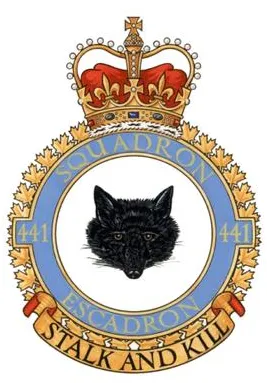
No 441 (F) Squadron was formed in Sydney, NS  as No. 125 (F) Squadron RCAF on 20 April 1942. It flew Hawker Hurricane aircraft on East Coast air defence. It was the fourth of six home squadrons transferred overseas without its aircraft, and was re-designated No. 441 (F) Squadron RCAF at Digby, Lincolnshire, UK
as No. 125 (F) Squadron RCAF on 20 April 1942. It flew Hawker Hurricane aircraft on East Coast air defence. It was the fourth of six home squadrons transferred overseas without its aircraft, and was re-designated No. 441 (F) Squadron RCAF at Digby, Lincolnshire, UK  on February 8 1944. It flew Spitfire aircraft in offensive and defensive operations in the preparation for D-Day, and afterwards gave close support to the ground troops. It moved with the ground troops through France and Belgium, and returned to the UK in October 1944 and flew from various bases there until the end of hostilities in Europe. In May 1945 the squadron was re-equipped with Mustang aircraft, to provide fighter cover for long-range bomber groups, but were never operational in this role. The squadron was disbanded at Molesworth, Huntingdonshire, UK
on February 8 1944. It flew Spitfire aircraft in offensive and defensive operations in the preparation for D-Day, and afterwards gave close support to the ground troops. It moved with the ground troops through France and Belgium, and returned to the UK in October 1944 and flew from various bases there until the end of hostilities in Europe. In May 1945 the squadron was re-equipped with Mustang aircraft, to provide fighter cover for long-range bomber groups, but were never operational in this role. The squadron was disbanded at Molesworth, Huntingdonshire, UK  on August 7, 1945.
on August 7, 1945.
In the course of operations, the squadron flew 3148 sorties for the loss of16 pilots, of whom 2 were killed, 7 presumed dead and 6 POWs. They accounted for 56 enemy aircraft confirmed destroyed and 12 damaged. In ground attacks they were credited with 500-plus vehicles. The squadron had 3 aces: Flight Lieutenant D.H. Kimball, DFC; Flight Lieutenant G.E. Mott, DFC and Flight Lieutenant T.A. Brannigan DFC. The squadron amassed 9 DFCs, 1 Croix de Guerre (France) and 3 MiDs. Battle Honours were: Defence of Britain 1945, Fortress Europe 1944, France and Germany 1944-45, Normandy 1944, Arnhem, Walcheren.Wikipedia, Kostenuk and Griffin
Maps for Movements of 441 Squadron 1944-45
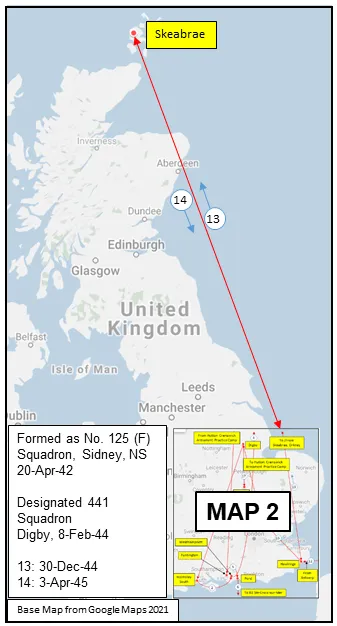
MAP 1: 441 Squadron Movements 1944-45 (right-click on image to display enlarged in new tab)
|

MAP 2: 441 Squadron Movements 1944-45 (Detail of Map 1)
|
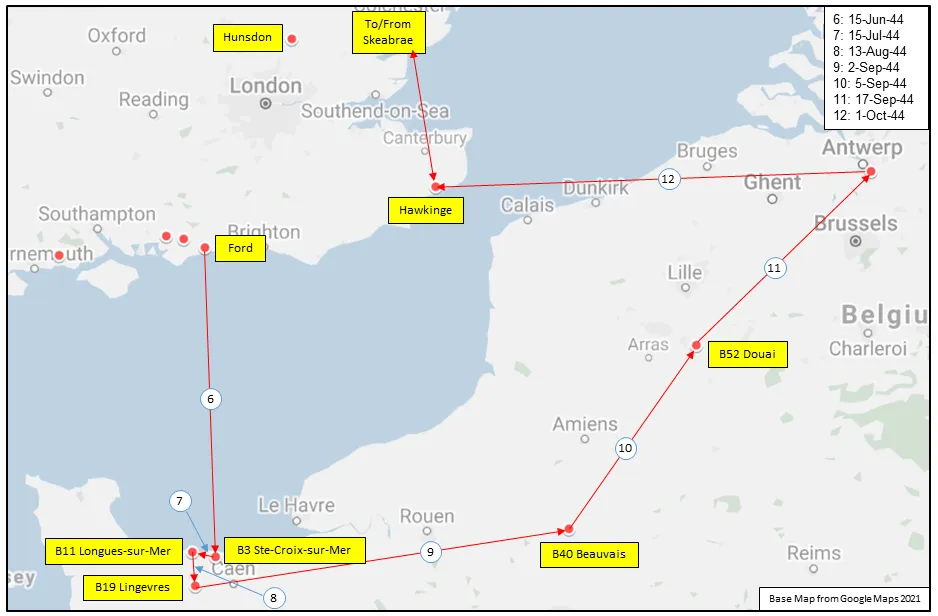
441 Squadron History Summary 1944-45
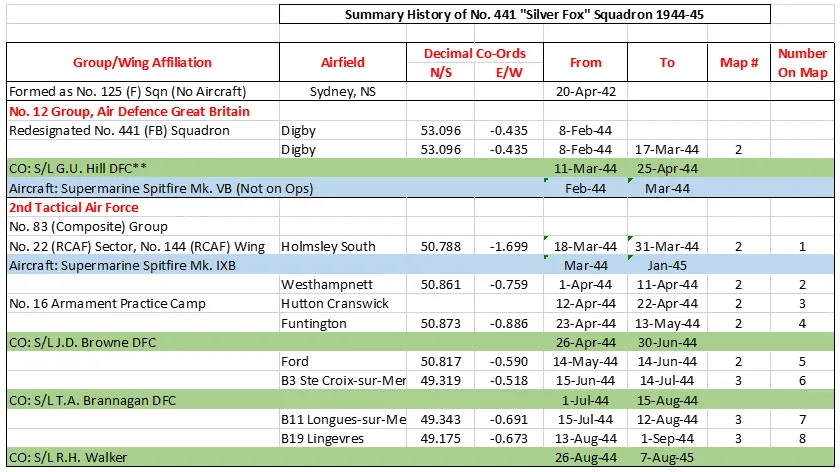
441 Squadron History Summary 1944-45 Page 2
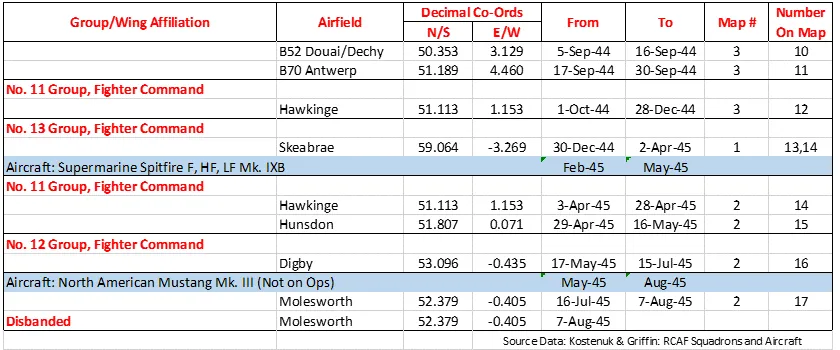
History of the Squadron Post-WWII (Aircraft: Vampire III, Sabre 2, 5, 6, Starfighter, Hornet)
No 441 Squadron reformed at RCAF Station St. Hubert  on 1 March 1951, flying de Havilland Vampire III and later Canadair Sabre Mks. 2, 5 and 6. They joined No 1 (Fighter) Wing, then located at RAF North Luffenham, in Rutland, England
on 1 March 1951, flying de Havilland Vampire III and later Canadair Sabre Mks. 2, 5 and 6. They joined No 1 (Fighter) Wing, then located at RAF North Luffenham, in Rutland, England  on 13 February 1952. The squadron was temporarily situated at 3 Wing Zweibrücken, Germany
on 13 February 1952. The squadron was temporarily situated at 3 Wing Zweibrücken, Germany  on 21 December 1954, before moving to their intended destination, RCAF Station Marville, France
on 21 December 1954, before moving to their intended destination, RCAF Station Marville, France  . It was selected as one of the eight squadrons to be re-equipped with the CF-104 Starfighter, so it was deactivated on 1 September 1963 at Marville and then reactivated (reformed) as No 441 Strike/Attack squadron on 15 September. It then moved with 1 Wing to CFB Lahr, Germany
. It was selected as one of the eight squadrons to be re-equipped with the CF-104 Starfighter, so it was deactivated on 1 September 1963 at Marville and then reactivated (reformed) as No 441 Strike/Attack squadron on 15 September. It then moved with 1 Wing to CFB Lahr, Germany  in April 1967. On 1 February 1968 the squadron was integrated into the Canadian Armed Forces. In 1971 the squadron moved to CFB Baden-Soellingen
in April 1967. On 1 February 1968 the squadron was integrated into the Canadian Armed Forces. In 1971 the squadron moved to CFB Baden-Soellingen  and changed its name to 441 Tactical Fighter Squadron. They disbanded again in 1986 and then finally reformed at 4 Wing Cold Lake, Alberta
and changed its name to 441 Tactical Fighter Squadron. They disbanded again in 1986 and then finally reformed at 4 Wing Cold Lake, Alberta  on 26 June 1986, flying CF-18 Hornet aircraft. The squadron flew mostly close air support and battlefield air interdiction missions over Kosovo and the Federal Republic of Yugoslavia, under Task Force Aviano, 5 Allied Tactical Air Force from 12 April to 10 June 1999.
on 26 June 1986, flying CF-18 Hornet aircraft. The squadron flew mostly close air support and battlefield air interdiction missions over Kosovo and the Federal Republic of Yugoslavia, under Task Force Aviano, 5 Allied Tactical Air Force from 12 April to 10 June 1999.
On 6 July 2006, No 441 Squadron was finally stood down (disbanded), and its crews amalgamated with 416 Tactical Fighter Squadron at CFB Cold Lake and re-formed as 409 Tactical Fighter Squadron. The squadron's colours and battle honours have been placed in Sydney, Nova Scotia, where it first operated.
 Library and Archives Canada Service Files (may not exist)
Library and Archives Canada Service Files (may not exist) Harold A Skaarup Web Page
Harold A Skaarup Web Page YouTube How the Spitfire Became an Aviation Masterpiece
YouTube How the Spitfire Became an Aviation Masterpiece RCAF Supermarine Spitfire Serials - Kestrel Publications
RCAF Supermarine Spitfire Serials - Kestrel Publications